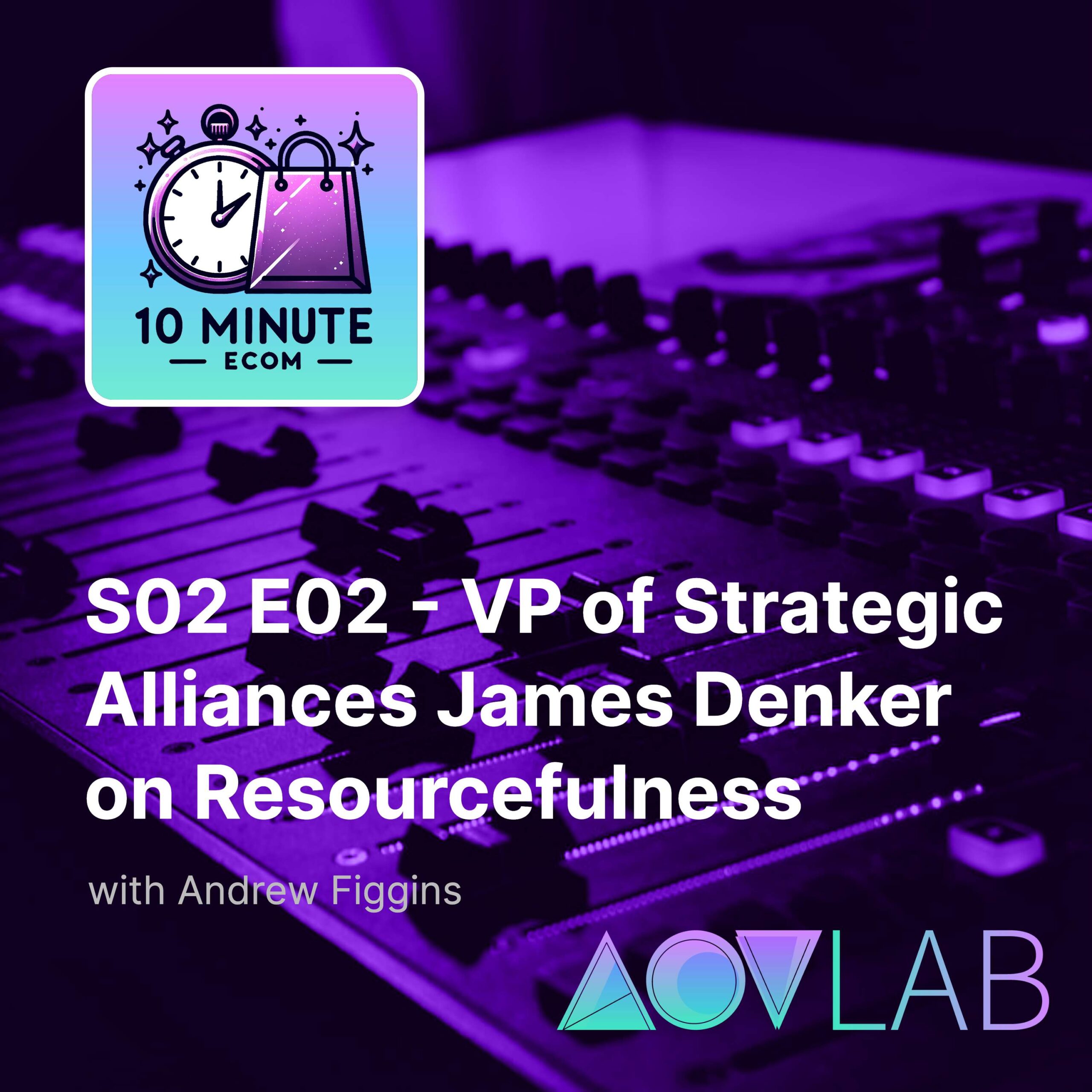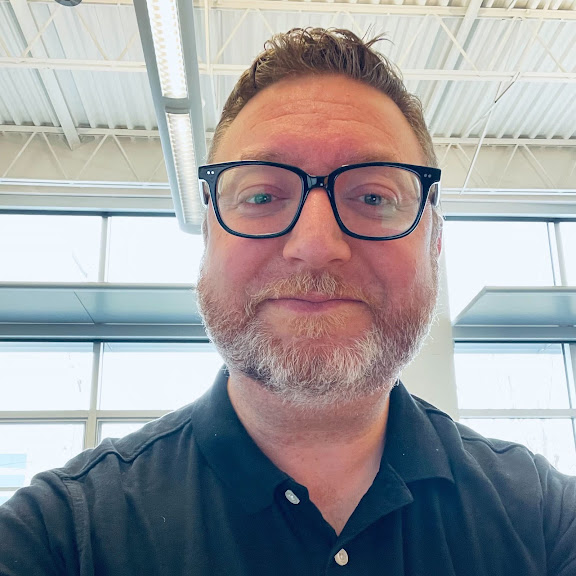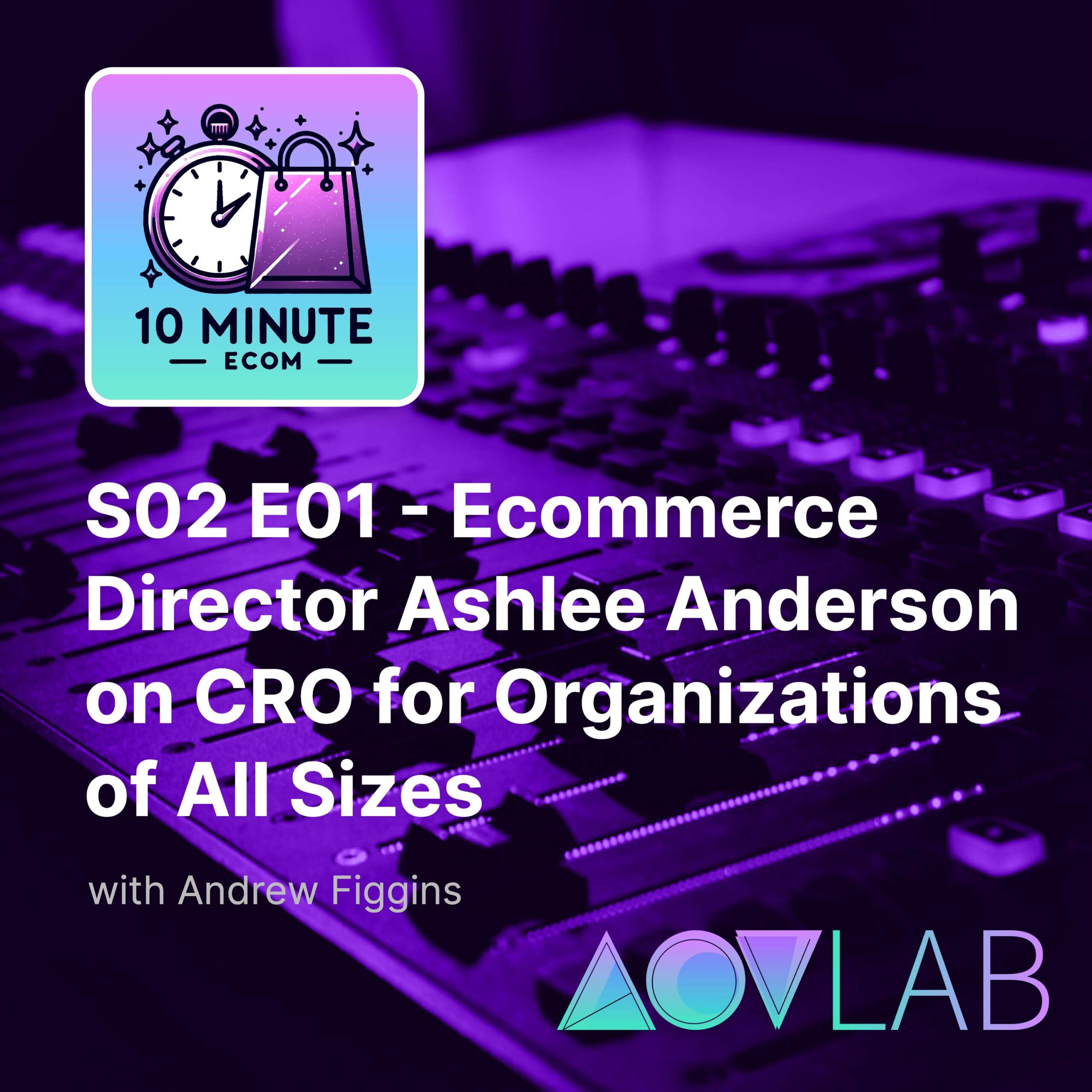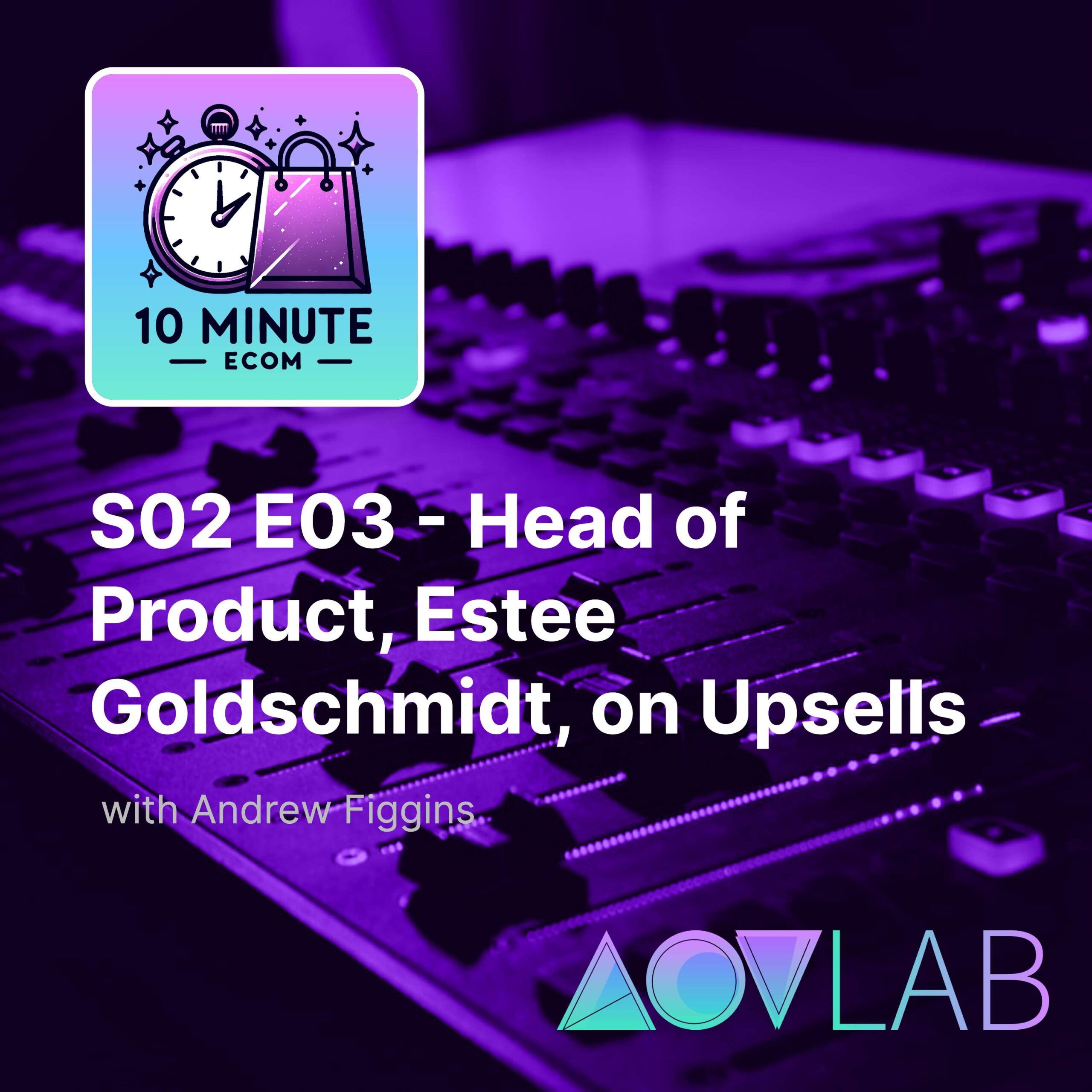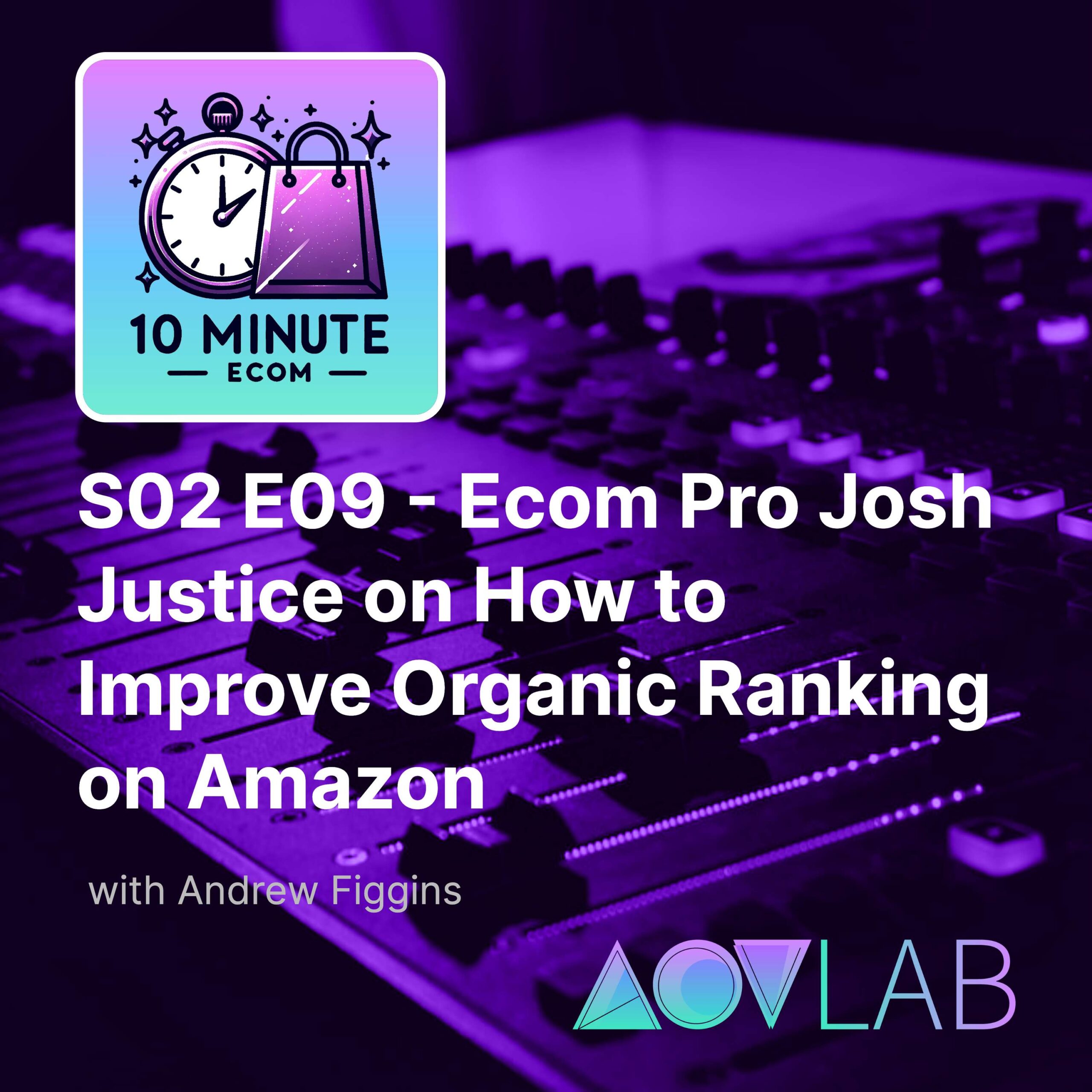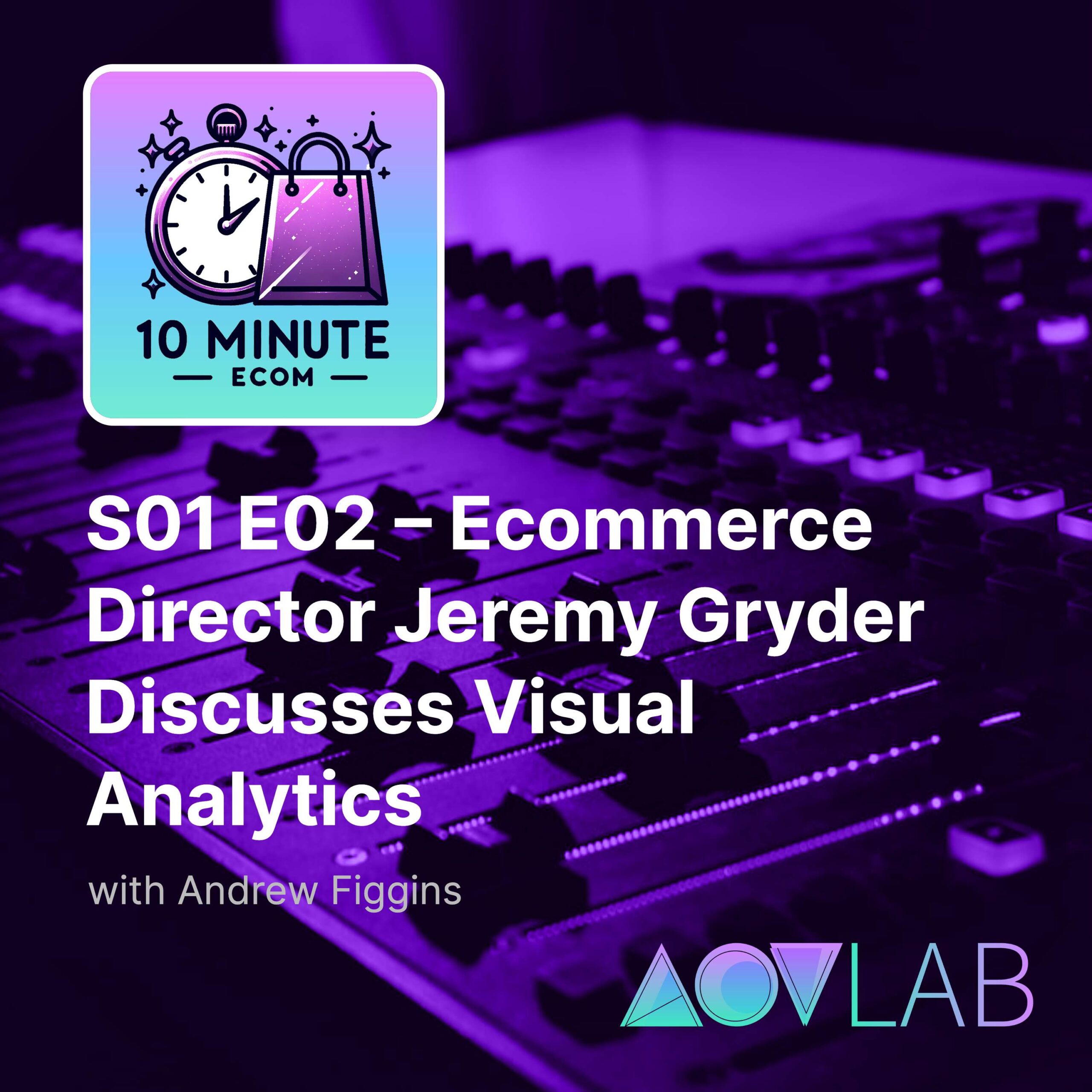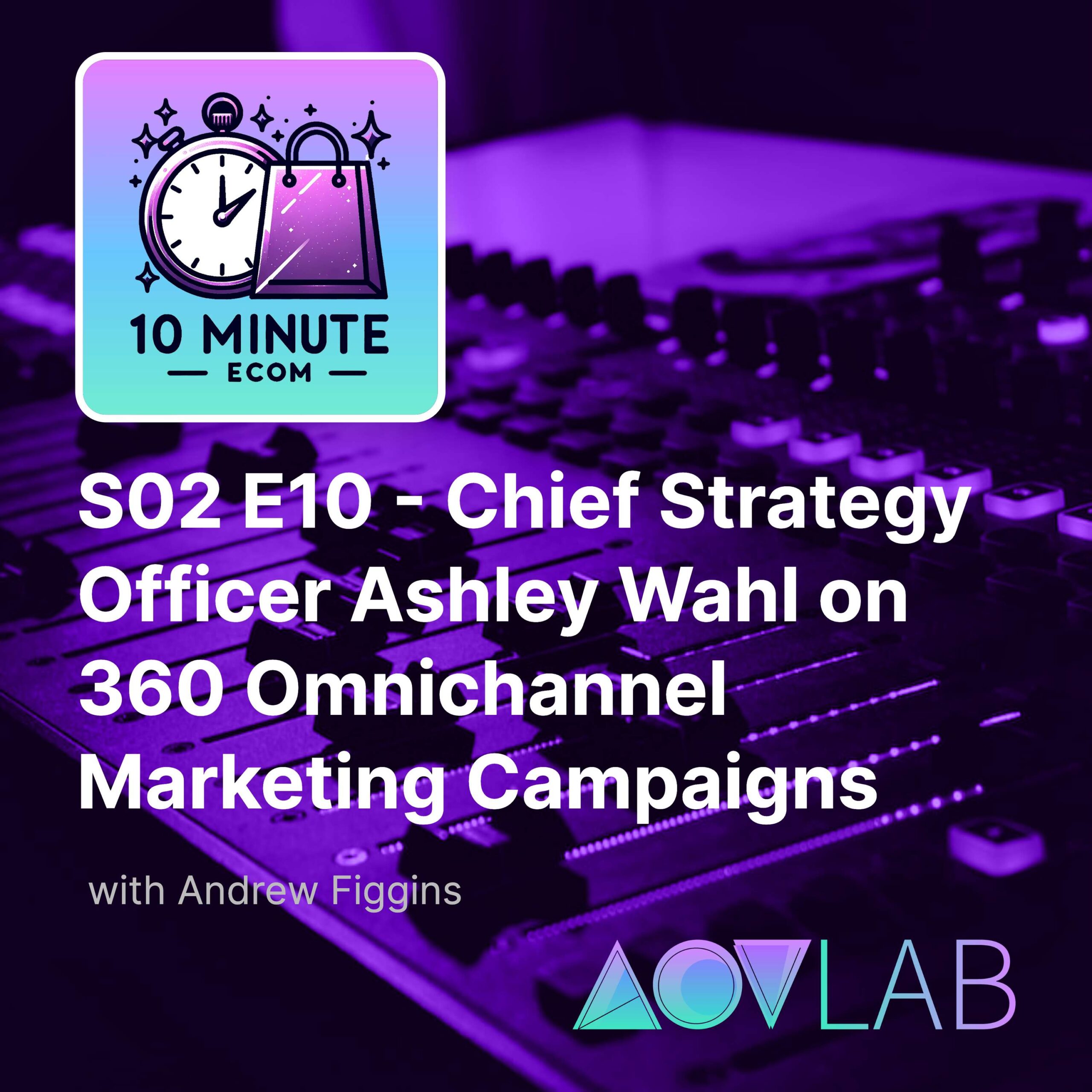View Full Transcript
Episode Transcript
[00:00:07] Speaker A: Hello, ecommerce fans, and welcome to ten minute ECom, an AOV Lab podcast. Every episode we break down a new and different tactic that can help you improve your ecommerce KPIs key performance indicators I'm your host, Andrew Figgins, and like most of you, I am an ecommerce professional. You may know me as the founder of AOV Lab, the former vp of product innovation at Scrubs and beyond, or is the former director of e commerce technology at Rural King. Today I'm excited to be talking to James Denker, an e commerce colleague that.
[00:00:38] Speaker B: I go way back with and who.
[00:00:40] Speaker A: Is doing incredibly interesting work in e commerce. Anyway, James, what did you come on the show today to share with your e commerce colleagues?
[00:00:47] Speaker C: Hi, my name is James Danker, VP at Iron Digital. I work at a Boca retailer headquarters, but we have other offices. One thing I've seen that works in ECom is being resourceful.
[00:00:57] Speaker A: Thank you, James. After the ad, we'll get right into the chat.
Today's episode of ten minute Ecom is brought to you by shop AOV Lab. It is a brand new store with fun apparel and gear specifically for Ecom professionals just like you and me. We've got high quality embroidered and printed t shirts, hoodies and hats that will spice up any Zoom call or in person meeting with your team. If you lead a team, these products make for awesome gifts to celebrate hitting a conversion rate or average order value milestone. If you work in ecommerce, I think you'll not only find some humor in these products, but also a sense of pride for what you do every day. Again, the site is shop aov lablab.com. Head over right now and browse while you listen. Unless you're driving, in that case, pull over. You've got to see and share these products one last time. The website is shop aov lablab.com.
And now, back to the show.
[00:02:02] Speaker B: Yeah, I think we can just dive right into it. I think 2023 was a tough year for ECoM, James, as we know, and it's a pleasure to have you here on ten minute Ecom today. But 2023, and I was one of the so called victims of cost cutting and everything. I worked for a company that was looking to really manage their costs. Since I was a casualty, my position was eliminated. But 2024, we expect. I think we're already starting to see some changes happen. But I love the topic you brought today, being resourceful. Because no matter if you're looking for a new role or you're in your current role, obviously being more resourceful is going to be of high value.
[00:02:41] Speaker C: Sure. I think they are short sighted in their decision making process at your former company, but I definitely appreciate the time to reconnect. It's been a long time. So great to see you. So just a little bit about me.
[00:02:54] Speaker B: Right.
[00:02:54] Speaker C: My name is James Thanker. I'm a vp at IAM Digital. We recently rebranded right around shop Tart last year and we're a full service e commerce agency and really built for upper mid markets and mature retailers focused on bespoke commerce solutions.
[00:03:12] Speaker B: Very good, James. And tell me a little bit about this topic that you brought today and being more like when you just think about that topic or that word, I'm curious what comes to mind. In what ways do you want to talk about becoming more resourceful?
[00:03:27] Speaker C: I would say if I am the smartest person in the room, I don't want to be in that room. But given that I'm usually not the smartest person in the room, I'd like to call myself the most resourceful person in the room. So I think the best way to start that off is by defining what that is from a business perspective. And it's really the ability to creatively cope with problems and obstacles that you're faced. And how about problem solving is applied in those scenarios? So that's usually how I look at approaching a specific scenario in this insanely fast paced, iterative industry that we are in an ecommerce. Right?
[00:04:10] Speaker B: Yeah, that's certainly something I've seen in my last two roles, is that there's a wall, and I guess I'd call it like the normal wall that a lot of ecommerce professionals hit. Right. And no matter if you're trying to raise an important KPI conversion or AOv or revenue, you're going to hit that wall. You're going to face some huge challenges. But when those challenges come up, whether they're external or internal, how do you see that ability to get over that hurdle? What do you think are some of the ingredients of being able to be that problem solver that can go a little bit further than maybe others have in the past?
[00:04:48] Speaker C: Yeah, I appreciate the question, and I think scenario based problems are an easier way to apply it. So maybe it was your boss asking you for something you've never done before. Maybe it was a client evaluating bounce rate. Just very bespoke. I think the common denominator for me is always being present. And how do I analyze the market in a way that is going to be fruitful for whatever you do behind the curtains, in front of the curtains, whatever. How do you bridge the gap? A lot of times I find myself looking for articles and other thought leaders in the industry. So two things that come to mind, a one stop shop for me that's great is WGSN. Where is this kind of collective view? From a creative perspective, from a strategy perspective, from a marketing, from a technology, from a leadership perspective, on these bespoke verticals, on these bespoke engagements with the customers. It's a very holistic viewpoint of how I look to digest a specific problem and turn that into a solution a little bit more tired of the pavement in terms of going through those types of scenario based questions and market leading insight. I'd also say, like my friends, that Philip Jackson and Brian Lang over at future commerce and people such as yourself, right as we start evangelizing, what are these podcasts that are going to help give me different perspective on how I'm viewing a specific problem and how do I want to address it differently. So taking different pieces of inspiration almost gives you a buffet of how you want to approach it and taking that and turning it into something that you created yourself as the end result.
[00:06:33] Speaker B: I think that's well said. I think it's a good point too, to say I think this somewhere around the 20th episode or so of ten minute Ecom, and it's something I was actually just thinking about the other day when I was editing one of the episodes, is if you're an ecommerce VP or director and you're trying to take every single tactic that we share on the show, or shared on the show and apply it, you're not going to get very far because no one can do that. We have to have focus and we have to understand what our biggest challenges are. What are some of the ways that you identify those big challenges? When you're starting to get involved with a brand new ecommerce brand, it's just.
[00:07:18] Speaker C: A ton of discovery. You don't know that client's business better than they do. So the best thing to do is to be a student of your prospects or your customers. We go through a pretty extensive process on our side. Usually it starts with an initial discovery, identifying the problem statement, identifying the goal. Maybe that translates to a marketing initiative. Maybe that translates to a CFO initiative for total cost of ownership in terms of how maintenance plays into and the developers play into what it costs to keep the lights on. Maybe some business value management that comes into play. The better I can take notes and best understand your business, whether it's a vertical that we've worked with or a vertical that is new to us is the best method for success. And depending if it's a marketing problem or a technology problem, we have leaders in that business that could help appropriate the best solution, from creative design, visual design, engineering, to a marketing ambition. So I'd probably pause there because you can go in so many different directions in terms of how you want to tackle the problem, but it's a great place to start.
[00:08:30] Speaker B: One thing we were chatting about just over, I can't remember if it was email or LinkedIn, but you mentioned being able to step into the client's business a little bit after doing that discovery and understanding and actually being able to speak a little bit into some of the business processes that are happening. And I know just from my days consulting or even internally at some ecommerce brands, it can be a challenge to be heard when it comes to improving those business processes, do you have a way that you approach that or how do you convince the client basically to listen to your process advice?
[00:09:09] Speaker C: I think the easiest thing is trying to be as conservative in terms of benchmarking, right? There's industry benchmarks, there's vertical specific benchmarks. And then let's say we're doing a retention marketing project. You want to go in and understand what's the RFM modeling of what that business looks like? What's the recency, frequency and monetary value of the specific customers.
Is this a mature business that has GCP products like looker and they have specific data visualization dashboards for specific marketing leadership where they want to know the revenue per recipient of that specific email engagement? Maybe it needs a sunset flow, maybe it's a different type, maybe it's an art company and how many pieces of art you're going to buy. Right. So there's this whole acquisition and retention model that doesn't work necessarily for every business. How many pieces of wall you're going to put up under and then what type of insights are going to be coming from that to indicate that there's another opportunity? And how are we going to personalize that to send that right message at the right time? So having corporate b two B business dev plays in place from interior design marketers and having partnerships there and really thinking holistically around the problem goes down its own rabbit hole each.
[00:10:28] Speaker B: Right.
[00:10:29] Speaker C: So we're going to be able to start formulating a specific solution and it always comes down to what's the quality of that data, right. And how engaged that audience relative to the business model and then how can we apply that to either a plus or minus, whether that's a healthy, whether it's eliminating technical debt or whatever the case may be, that will help you make a best informed decision for return on investment.
[00:10:57] Speaker B: Excellent, James, thanks for sharing that. And I want to ask you more about resourcefulness and maybe your own story. A little bit about feeling like you can be that most resourceful person in the room.
Is there something from your background or like maybe a story you can share about just using some of your listening skills and discovery skills and all your skills really to face down a really challenging problem and help the client find a solution?
[00:11:29] Speaker C: One example that comes to mind of a challenging situation was a private equity firm that was looking to acquire a CBD company. That CBD company was essentially from inception as a part of their initial business plan. New product to market, new direct to consumer. And it's this lifestyle brand. And the lifestyle brand, how does that translate to marketing? How does that translate to specific customer touch points? How does that translate from a gender perspective? What are the male individuals that are interested in the product? What do they want to hear? What do the women want to hear? And how should this be incorporated into this person's life? So this really extensive discovery project, if you will, in terms of firing out brand guidelines, brand voice, brand narrative, a lot of that had to come down to surveys of just customers out in the wild. What CBD products are you using today? Why are you using them? Sampling that data of a couple hundred people is just as an initial project, an initial consensus to validate a specific intention.
And what we learned is, if it's men, it's ways to cope with stress.
If it's someone who's in a lifestyle capacity, likes to go to the gym every day, it has a lot to do with combating inflammation. Right. If it's women, it's also a similar narrative to deal with stress, maybe not so much on the inflammation for workouts for women. So building these types of narratives and building that type of consensus helped us dictate what the visual design and the creative design and what the UX ultimately is going to look like. How's that going to translate in terms of our messaging? What type of a b tests from educational versus technical content? Almost technical, like health content. Right. Without making too many medical claims. Right. Of how those journeys are going to be incorporated into someone's life. Right. And you can highlight that through professional athletes.
One specific athlete was a professional volleyball player. Another one was an up and coming boxer who made it to some of the top promotions and how that translates to their following and connecting those specific data silos throughout marketing campaigns, social retention, et cetera. And how do we bring that all together? So, for someone like I am digital, we're traditional of taking a business that has a brand voice, has a brand narrative. Someone already knows what they're about, what those touch points are going to be, and we come in with the fine sandpaper or demonstrate new a b testing or new strategies. So coming from something that's an established, almost household name to something brand new was a big challenge for us in terms of establishing a footprint. And how do we build that cookie, that breadcrumb trail, in terms of building something that we could grow with that specific customer? And how do those products eventually evangelize from CBD into, like, sleep gums? And how's that more of a holistic process that they can incorporate into their lives?
[00:15:04] Speaker B: Absolutely. Yeah. I think it makes so much sense for the brands that can afford an agency like I am digital, to work with an agency like yours, because you have a lot of expertise in the room, so to speak. There's a lot that you can share with that client broadly, but also specifically because as an agency, you're able to work with a lot of brands simultaneously. But then, of course, over the years. So it's a very valuable perspective both for your clients and, of course, for our listeners on ten minute Ecom. So, James, it is ten minute Ecom. It's a brief show, not a lot of time, but I wanted to ask you, before we head off today for your colleagues in ecommerce, is there anything else that you'd like to share with them today?
[00:15:51] Speaker C: Starting the new year for me is always pretty important, but I only had a week off when we were off camera to help evaluate the progress that I made personally, ecommerce professional and how that applies to 2024 goals. I think now that we're on record and how we're benchmarking where we were and where we're headed, everyone wants to move that needle up. But how does that actually translate right? And how can we be realistic in goals? I think from a year over year perspective, that is a tough thing to realize for retailers is meeting those types of demands, whether it's private equity or unrealistic expectations from leadership. Because of the accelerated pace of what ECoM has been, especially in the past four to five years, how can we find ways to find incremental growth in existing and then new strategies? So any parting ways? I would absolutely recommend you to head to specific keynote leadership that you could find at trade shows, the ones that's coming up in short order, is NRF or shop talk. They have anything from Walmart, et cetera, et cetera, in terms of brands that you need to understand that is either a critical part of your business from a marketplace perspective or just a leader in your industry, maybe like Sephora, and you want to understand how they're evangelizing the CPG beauty industry. I definitely defer to some of that leadership in terms of how they're making their bets, who has a much bigger purse to make their investments on. But I hope that gives you enough inspiration in terms of being resourceful and tying these things all together. And we don't always have to have the answers ourselves. And how can we leverage that in the community that we have today?
[00:17:37] Speaker B: Yes, and I'm happy to admit, and quick to admit, that I'm certainly not the person with all the answers. But James, I feel like I got some more answers from you today, so I really appreciate your time. Thanks so much for coming on the show.
[00:17:50] Speaker C: Thank you, Andrew. I appreciate it.
[00:17:51] Speaker A: Well, we have hit that ten minute mark, so that's a wrap for today's episode. I want to again thank our guest, James Denker.
[00:17:57] Speaker B: If you have a moment, be sure.
[00:17:59] Speaker A: To subscribe like or follow the show on Apple Podcasts, Spotify, Amazon Music, Google Podcasts, or wherever it is that you listen. As mentioned earlier in the episode, please head on over to shop AOv Lab, our brand new store that helps to support this podcast. It is launching with nearly 100 products, so plenty to choose from. Our top seller so far is a shirt that simply says Ecom on it. I wear it around my extended family so I can point to it when my relatives ask me what I do.
I hope you enjoyed this episode of the show. Until next time, this is Andrew Figgins signing off and saying have a good one.
